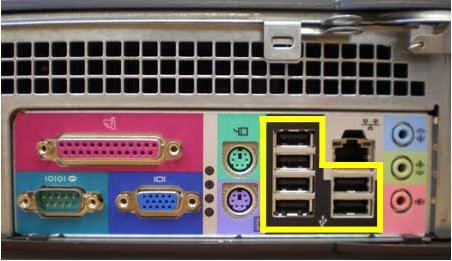Are All USB Ports the Same?
Current models of computers have almost completely eliminated older connections for printers (25 pin parallel), serial devices (9-pin), and even the round PS/2 type keyboard and mouse plugs. Virtually all that's left are USB (Universal Serial Bus) ports - seemingly never enough of them. But, are all USB ports really the same?
USB ports themselves have evolved over time. Older computers supported USB 1.1, which could transfer up to 12 megabits of data per second (mbps). USB 2.0, the standard used in most computers today, is rated at up to 480 mbps. The new standard is slowly moving toward USB 3.0, which can operate at up to 5 gigabits per second (gbps), nearly ten times the speed of USB 2.0. USB 1.1, 2.0, and 3.0 connectors are the same, and while USB cables may be rated as 1.1, 2.0, or 3.0 compatible, the differences are largely in manufacturing quality, not design.

USB devices (printers, memory sticks, mice, etc.) are designed to operate at a certain level (USB 1.1, 2.0, or 3.0), but both the devices and the computer USB ports are backward-compatible - you can generally plug any USB device into any USB port and the two will communicate at the fastest speed that both can support. (If, for example, you connect a USB 2.0 device to a USB 1.1 port, you'll see a warning that 'This device could operate faster' if it was connected to a USB 2.0 port. If you connect a USB 2.0 device into a USB 3.0 port, it will still operate, but at 2.0 speed).
On any particular computer, all of the USB ports operate at the same level, although a few desktops and some laptops now provide a single USB 3.0 port (clearly identified) with the remaining ports at 2.0.
In theory, on any computer, all USB 2.0 ports (for example) should be the same. That means the same power and speed should be available at every USB port, front or back, and you should be able to plug any USB device into any USB port. However, design and manufacturing realities make this not always true. The back USB ports are soldered directly into the computer motherboard, while the front ports are 'plugged into' the motherboard via cable, sometimes a foot or more in length. Although this configuration is still pretty reliable, remember the adage that, the more complicated the system, the greater chance for something to go wrong.
On occasion, some USB ports will fail, or at least won't operate at the expected speed or with certain types of devices. If you have a problem operating a USB device, try plugging it into a different port. Although every USB port is supposed to be the same, we've found that sometimes that just isn't true.
Erie County Bar Association
www.eriebar.com
Tips provided by Richard D. Vasil, Vasil Consulting, Inc.
© 2012 Vasil Consulting, Inc.


